Long gone are the days of paying 1 or 5 cents for clicks on Google Ads.
Today, clicks are expensive. And a high cost per click means that advertisers have to find a balance between profit and traffic.
Paying a higher cost per click can get your more visitors, but it will eat into your profits. Bid too low, and your ads won’t even show up.
This is a daily struggle for most advertising campaigns. And when the competition heats up, like during the holiday season, finding that balance becomes even harder.
Because if you were struggling to get to profitability on an average day, you’ll have a very hard time making the numbers work on days like Black Friday.
In this article, I’ll show you how to keep your cost per clicks in check throughout the year, and what you can do to make those high CPCs work for you!
Here is what we’ll cover:
- The Rise of The CPCs
- High CPCs Eat Your Profits
- Cop-out or Opt-out?
- How Quality Score Affect Your Cost Per Click
- 4 Hacks To Lower CPCs
The Rise of the CPCs
CPCs have been on the rise since the inception of Google Ads.
Here is a look at the cost per click for the past two years:
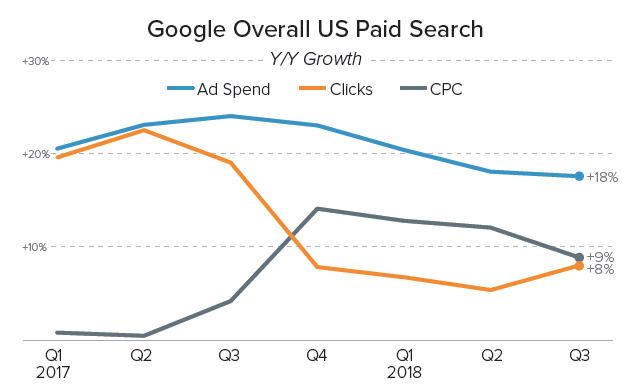
Note that the graph is showing Y/Y growth. So all three variables have been growing, the slope indicates how fast.
Why is the cost per clicks going up?
Advertising platforms like Google Ads and Facebook run an auction to sell their advertising inventory. Inventory here means the number of ads on a specific Google Search result.
In the beginning, there were few advertisers and a lot of available space to show ads. But over the years, more and more search results have been plastered with ads as more advertisers have started with Google Ads.
And like any auction, more participants means higher prices (in this cases higher cost per clicks). Which has made it harder to make Google Ads work.
High Cost Per Clicks Eat Your Profits
High cost per clicks and profit are adversaries.
The more you pay for each click, the higher your customer acquisition cost will be which means lower profit.
Let me take you through an example to show that impact.
Current situation:
- Customer acquisition cost: $12
- Cost per click: $0.4
Formula: Number of clicks * CPC = CAC
X * $0.4 = $12
X = you need 30 clicks to make a sale (∼ a 3% conversion rate)
At a CAC of $12, you’re just breaking even. So you can’t afford to pay any more.
But if during the holiday season the CPCs goes up 30%, your CAC will also go up by that amount to stay at the same level of sales.
Holiday season CAC: $15.6
So if $12 / sale was your break-even point, you can’t afford to pay more for each click.
If this happens you have two options: pull out or find a way to lower your CPC.
Cop-out or Opt-out?
Switching off your ads during busy shopping days is a controversial topic.
Because many store owners are convinced they need to be there.
If it is THE shopping period of the year and everyone has their wallet out, are you an idiot for not trying everything you can to get customers?
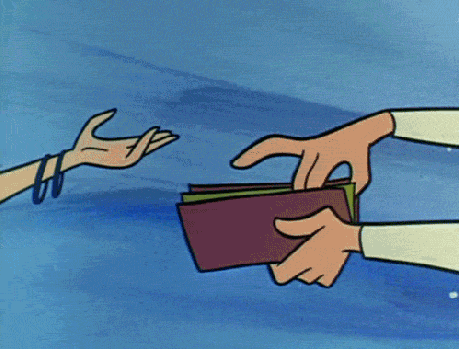
But if you are planning to use advertising to drive all of your traffic, the math has to make sense. There is no point spending on ads to drive sales if you’re losing money on every order.
Because on days like Black Friday and Cyber Monday, on top of paying for more expensive clicks, you also need to do something special to get the actual sales. Maybe it’s free shipping or extra discounts.
Add all of these together and they can leave you with a bad Black Friday hangover.
Some established businesses have a system in place that allows them to lose money on the first order, and make up for it on repeat orders. But that’s a risky and expensive game to play, especially is your store is new and unproven.
But it doesn’t have to be all or nothing.
If you look across all your campaigns your overall customer acquisition cost might be too high.
But a good strategy defines where you should play. So if you look closer, can you find campaigns, categories, brands or even products that are more promising?
Promising might mean that you’re on the brink of profitability, if only you shave a couple of dollars off.
Before we look at a couple of ways to lower your CPC, you need to understand what goes on behind the scenes of Google Ads.
How Quality Score Affect Your Cost Per Click
As I’ve shown above, market forces will drive up the CPC.
And Google gladly uses this to nudge you at every turn to increase your bid to get on the first page:
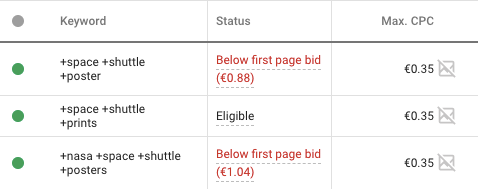
I told you before that Google Ads functions like an auction.
But unlike a regular auction, it doesn’t just take into account the amount someone is willing to pay (the max CPC). Because that would mean that the person that pays the most shows up on top.
That could be good for Google in the short term (more money), but it would lower the quality of their product over time.
So to take that element into account, it calculates the relevance of showing a specific ad for a specific search query.
This is called the quality score. It’s a score ranging from 1-10 and Google calculates it every time someone uses the search engine.
You can see this actual score if you click on the status of a specific keyword in your account:
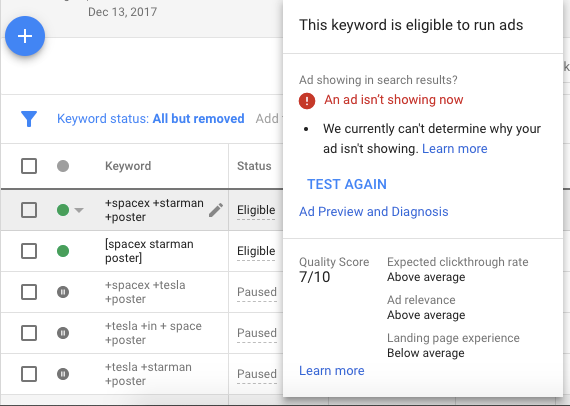
To decide the actual order of the ads on the page, Google takes this quality scores and multiplies it with the max CPC.
This means that a high-quality score can compensate for a lower bid. And that a low-quality score needs a high max CPC in order to compete.
As of late 2018, a quality score of 7/10 is considered neutral territory. Any lower and you have to pay more per click, any higher and your clicks become a little cheaper.
Google doesn’t reveal exactly how they calculate the quality score, but they have said that the three most important parts are:
- Expected clickthrough rate
- Ad relevance
- Landing page experience
So if you want to lower your actual cost per click on Google Ads, working on your quality score is something that’s very valuable.
When I mention this to new advertisers, they start obsessing over the actual number. But I try to look at it more as an indicator of how relevant your ad is to the person on the other side typing in that query.
So if you keep this in mind while you’re creating and improving your campaigns, the tactics below will make a lot more sense.
4 Hacks To Lower Your Google Ads Cost Per Click
#1 Ensure Keyword & Ad Match
Instead of focusing on the actual cost, I want you to step back and look at the keywords you have in each ad group.
Now look at the advertisment(s) you have in this ad group that will show when someone searches for these keywords.
Is the ad representative for all keywords?
An example from one of my own campaigns:
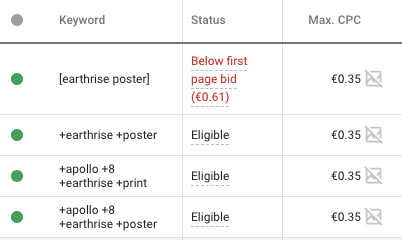
And this these are the ads that go with those keywords:
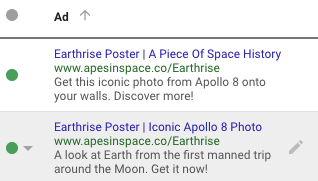
These are very specific. I had to look at the keywords, understand what they meant to create an ad that captures the intent behind these searches.
Getting this detailed for an ad group of 4 keywords with a low search volume isn’t always worth the effort. (It hasn’t been in this case 😅)
A good rule of thumb is to make sure your ad groups are fairly small, less than 20 keywords, and write an ad that represents all of those keywords.
#2 Get Smart About Keyword Match Types
Google will use your keywords to match them with the user search queries. How closely these search terms represent your keywords will depend on their match types.
If you’re using things like broad match, your keywords might be very different. In this case, a lot the effort you’ve put into making your ads match your keywords will be wasted.
Open up the search terms report to see the actual search terms:
Select your campaign > Keywords > Search terms
Here is mine:
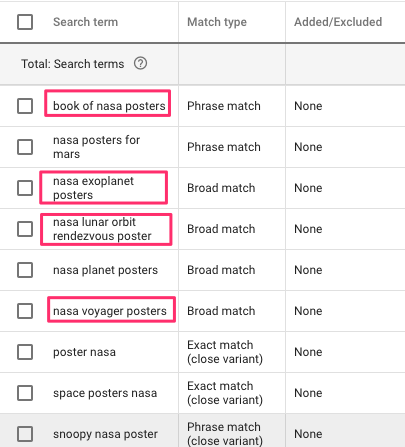
Now look again at your ads. Do they represent the searches in this report?
Here are mine:
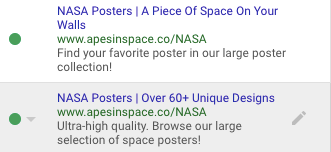
The ads aren’t irrelevant. But to someone looking for “nasa voyager poster”, they aren’t the best fit.
So, in this case, I might need to create a new ad group to target the search queries that don’t fit these ads. Or I can change the match type to show for more related queries. Or add I can add them to my negative keywords if I don’t have good results for these.
#3 Good vs Great Ads
Research has shown that the clickthrough rate is the most important variable in that quality score.
So you don’t just want a good ad, you want a great one. Especially for your top keywords.
That means your ad:
- is specific
- taps into the objections/fears/dreams/aspirations of a potential customer
- includes a call to action
- shows what makes your store different
You can see that these aren’t easy. To create great ads you’ll need to do research and will need to spend time writing them.
You’ll also want to create multiple ads for each ad group. Because even after 8 years of working with Google Ads, I can’t predict how well and ad will do. So I always create 2-3 ads per ad group and let Google test which one gets a better response.
To make your testing as effective as possible, select the “Optimize” as Ad rotation in the campaign settings:

#4 The Right Landing Page
The landing page experience is the third factor of the quality score.
Google knows what happens on your landing page. They know when a user doesn’t find what they were looking for and will punish you for it.
So it is key that you send ad clickers to the best page on your site for that specific search query.
If you’re using your homepage as a catch-all landing page, maybe it’s time to develop a few additional ones.
A good way to see whether this is happening is to look at the bounce rate of all your Google Ads landing pages in Google Analytics:
You can see the numbers varying wildly: 16-86%.
Your numbers might look different, but start looking at the highest numbers.
On line 4 for example, you can see I’m paying for 474 visitors to come to the site, but 86% of them leave straight away.
So there is a mismatch between the search query, ads and landing page. Investigating and fixing this can only be beneficial as it will result in either in a lower CPC, higher conversion rate or saved ad spend.
Lowering Your CPCs
I hope this article made clear that cost per clicks are rising and will keep on going up.
One of the key decisions as a smart advertiser is which of your products or categories are worth advertising on Google Ads.
Then once you’ve got your campaigns running, you need to make sure that your search query, ad and landing page are well aligned to ensure the best possible visitor experience.
That will improve your quality score and give more runway to your maximum cost per click.
Got other strategies or rules of thumb rule that you use? Share them in the comments!
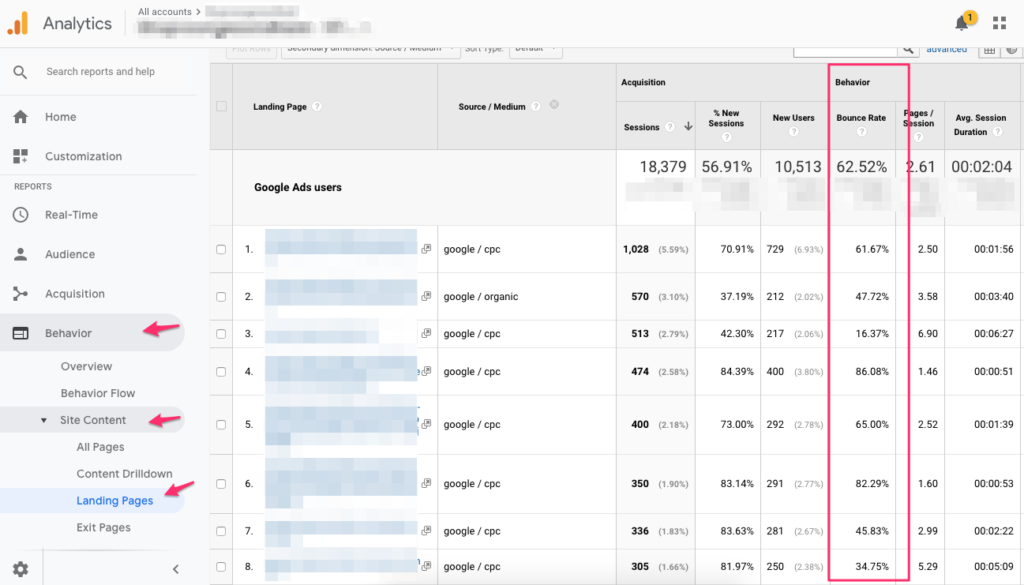

[…] are searches for the categories, problems or solutions. But these clicks can get expensive. So you need to make sure that your bidding strategy reflects the real value of these […]
I also use a lot of the smaller ppc ad networks for my marketing, because they generally have lower advertiser competition.
Such an informative and great article, every PPC beginner must read this article this is very helpful for me and peoples who want to become a PPC expert. I believe that PPC is one of the shortest ways to make money in digital marketing it gives you quick results of your investment but is a tricky process you need to be very careful while doing PPC.
You’re absolutely right Jerry. PPC can work very well, but it’s not always that easy to get right.
CPCs depend a lot on each niche – the health niche is one of the lowest I’ve ever worked on.
They do vary depending on the niche Valendi.
Thing is that if CPCs are low for everyone in the niche, your competitors enjoy those as well and the playing field is level.
It’s trying to find an uneven playing field where you can make the difference.
Missed to say something very important, the time the page loads for the customer. I loved the article.
Agreed Luke, a fast loading website contributes to good user experience. Working on speed does pay off!
Such a complete article! 😍
I learned a lot thank you very much Dennis!
As a skincare&cosmetics company, we will apply these best practices from now on 👍
Sol Lee
Global Business Department
Gladpick.kr